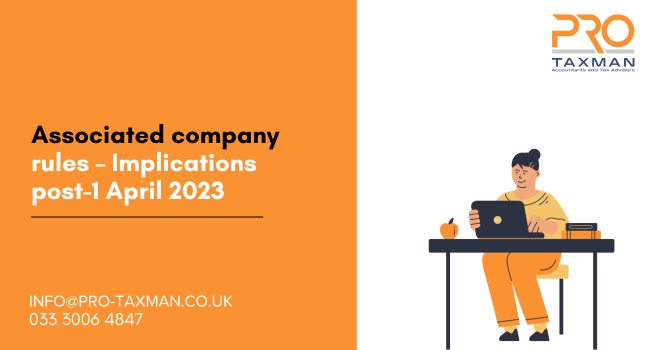It is eight years since companies had to deal with two tax rates and marginal relief when calculating their corporation tax liability. That system has now been reinstated and, as of 1 April 2023, the amount of corporation tax will depend on a company’s profits as follows:
- under £50,000 – small profits rate of 19%
- above £250,000 – main rate of 25%
- between £50,000 and £250,000 – main rate of 25% less marginal relief.
What some company owners may not appreciate is that these limits can be further reduced:
- proportionately for an accounting period less than 12 months, or
- divided by the total number of associated companies.
What is an associated company?
Two companies will be associated if:
- one has control of the other, or
- the same person, or persons, have control of both of them.
It is more likely the second condition which may catch some companies.
The associated company rules prevent a company from splitting or fragmenting its business activities between several companies and benefitting from the lower small profits rate – being associated for even one day in the relevant accounting period will be enough to be caught.
The table below shows the impact on the limits of up to four associated companies:
| Number of associated companies | Upper profits limit | Lower profits limit |
| No associated companies | £250,000 | £50,000 |
| One associated company | £125,000 | £25,000 |
| Two associated companies | £83,333 | £16,667 |
| Three associated companies | £62,500 | £12,500 |
‘Control’ has the same definition as for close companies i.e., the ability to control a company’s affairs, directly or indirectly, through the ownership of 51% or more share capital, voting power or any other rights to income and assets. Where the situation becomes complicated is when determining whether two companies are under the control of the same person or persons. Under this rule, two companies are under the control of the same persons if a group which controls one company is identical to a group which controls the other and, for each company, that group has a ‘minimum controlling combination’.
A ‘minimum controlling combination’ is a group of persons who have control but would not have if any one person was excluded. The way to work this out is to first consider all possible combinations of shareholders that own just over 50% of the first company. If any of these combinations match any of the combinations that own just over 50% of the second company then the two companies are associated.
For example, two companies have unconnected shareholders with the following levels of control:
Company 1
Mr Adams – 35%
Mr Brown – 35%
Mrs Georgio – 30%
Company 2
Mr Adams – 15%
Ms Duke – 45%
Mrs Georgio – 40%
In this combination, even though no one person controls both companies, the companies will be associated as they have a common minimum controlling combination in Mr Adams and Mrs Georgio.
Further, the rules state that where there is ‘substantial commercial interdependence’ between two companies, the rights and powers of each shareholder’s ‘associates’ will also need to be considered when working out whether the companies are associated. For example, if a husband and wife each have 100% control of their own companies, those companies will not be associated unless there is ‘substantial commercial interdependence’ between them.
The three types of ‘substantial commercial interdependence’ are where:
- Financial – one company financially supports the other, or each has a financial interest in the affairs of the same business or
- Economic – the companies have the same economic objective, common customers or the activities of one benefit the other or
- Organisational – the companies have common management, employees, premises or equipment.
One popular tax-efficient method of extracting surplus monies from a company is for company A to lend money to company B; company B then uses that money to purchase a buy to let investment property – both companies having the same director shareholders (control).Therefore,should a company lend to another under such circumstances, that may be enough to constitute ‘substantial commercial interdependence’ even if there is no other link between them.
Need professional accounting service or tax advice? Contact us to book a 15-min Free Consultation with us today.
To find out more please follow us on Facebook, Twitter, or LinkedIn. Feel free to contact us on 0333 006 4847 or request a call back by texting 075 6464 7474

